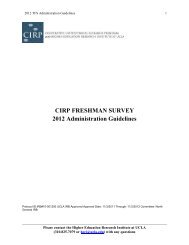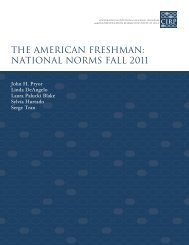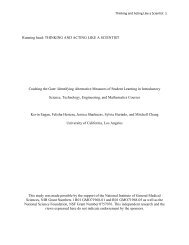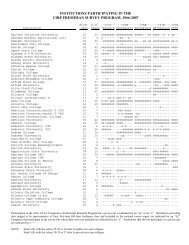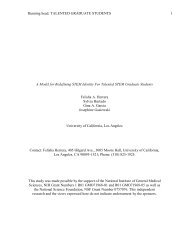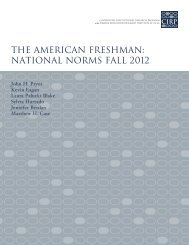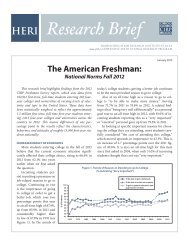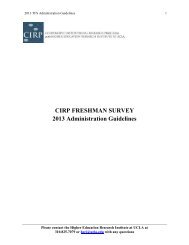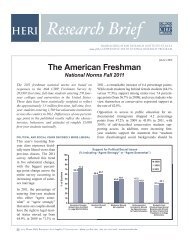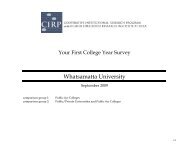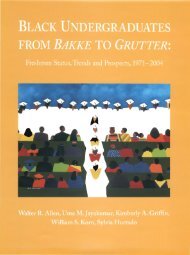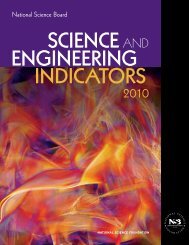North Dakota University System - Higher Education Research Institute
North Dakota University System - Higher Education Research Institute
North Dakota University System - Higher Education Research Institute
You also want an ePaper? Increase the reach of your titles
YUMPU automatically turns print PDFs into web optimized ePapers that Google loves.
Table 17<br />
Faculty Goals for Undergraduates Noted as Very Important or Essential:<br />
Percent Responding to Each Goal<br />
Doctoral Four-year Two-year<br />
<strong>Education</strong>al goals NDUS National NDUS National NDUS National<br />
Develop ability to think clearly 99.5 99.5 80.7 99.3 90.4 99.3<br />
Prepare for employment 77.1 64.4 68.8 73.5 85.2 82.5<br />
Prepare for graduate education 52.6 53.7 45.4 56.9 37.8 47.8<br />
Develop moral character 55.3 46.7 48.7 53.7 68.2 63.1<br />
Provide for emotional<br />
development 38.2 28.1 29.6 35.1 49.8 47.2<br />
Prepare for family living 13.5 9.5 11.7 15.0 31.8 26.6<br />
Teach classics of western<br />
civilization 24.0 25.6 25.8 28.9 15.1 22.0<br />
Help develop personal values 54.2 50.3 49.8 56.4 68.3 65.5<br />
Enhance out-of-class<br />
experience 47.4 35.3 35.1 42.3 44.9 47.0<br />
Enhance self-understanding 64.2 55.0 54.7 60.6 64.9 66.6<br />
Instill commitment to<br />
community service 36.2 28.6 33.4 36.4 46.7 39.0<br />
Prepare for responsible<br />
citizenship 61.0 53.0 48.9 60.8 65.1 63.2<br />
Enhance knowledge of and<br />
appreciation of race/ethnic<br />
groups 58.0 50.9 53.6 58.0 52.1 61.0<br />
Conclusion<br />
The HERI 1998-1999 Faculty Survey provides tremendous insight into the demographics,<br />
faculty time, publications and creative productions, instructional technology, goals, perceptions,<br />
and job-related stressors and satisfaction of <strong>North</strong> <strong>Dakota</strong> faculty. <strong>North</strong> <strong>Dakota</strong> doctorate<br />
institutions had the highest percentages of male faculty and the lowest percentages of female<br />
faculty members than at either the four-year or two-year institutions. Overall, percentages were<br />
lower than national averages at all three types of NDUS institutions except for the percentage of<br />
females at <strong>North</strong> <strong>Dakota</strong>’s four-year institutions and the percentage of males at <strong>North</strong> <strong>Dakota</strong>’s<br />
two-year institutions.<br />
Most NDUS doctoral faculty and two-year faculty indicated holding the rank of associate<br />
professor, while most four-year faculty held the rank of assistant professor. Percentages of <strong>North</strong><br />
<strong>Dakota</strong> faculty in terms of rank did not follow a consistent pattern when compared to national<br />
percentages. This may indicate that there were differences among the eleven institutions as to<br />
the definition of each rank. That is, what the level of a particular rank means at a doctoral<br />
institution may not be the same for a four-year or two-year institution.<br />
Faculty members from two-year institutions in <strong>North</strong> <strong>Dakota</strong> reported the highest percentages for<br />
tenured status. These percentages, along with those from <strong>North</strong> <strong>Dakota</strong>’s four-year institutions<br />
were higher than national percentages. Men and women from doctorate institutions in <strong>North</strong><br />
<strong>Dakota</strong>, however, indicated higher percentages of non-tenured status than the national norms.<br />
18



